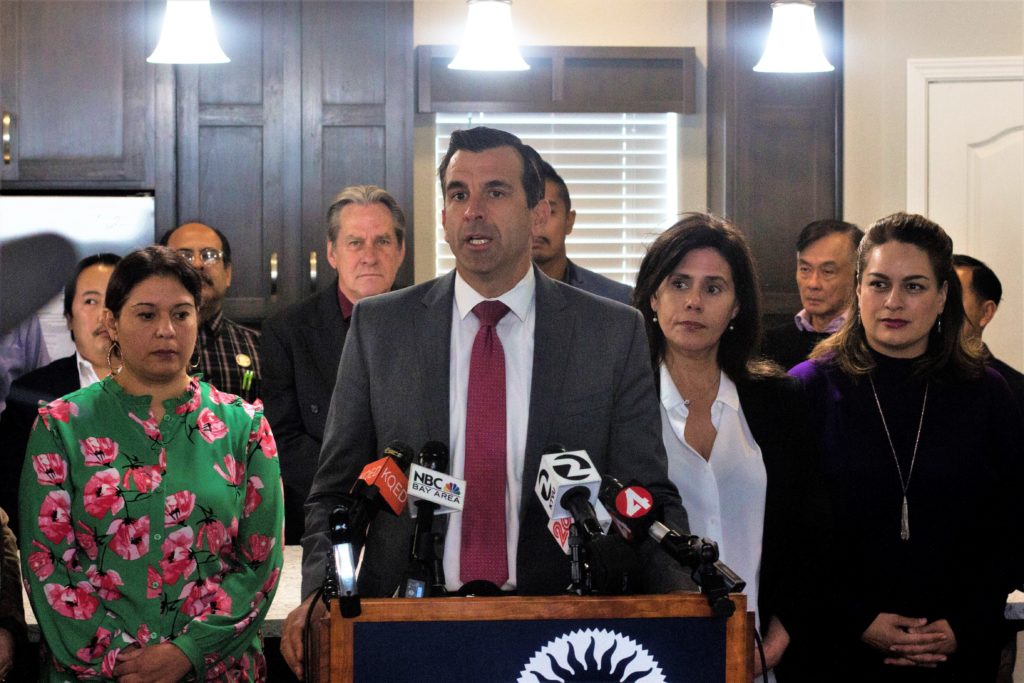With the shrinking supply of land in Silicon Valley driving up housing costs, some Bay Area leaders are banking on secondary units to save the region from its agonizing housing crisis.
The so-called “granny units” could be a gamechanger for beefing up the Bay Area’s housing supply, officials say, offering elderly or low-income residents an affordable home while utilizing existing land. The topic gained steam this week with the introduction of a new policy from Mayor Sam Liccardo and a distinguished panel on the topic as part of Affordable Housing Week.
The panel, hosted by Housing Trust Silicon Valley and AARP, featured Sen. Bob Wieckowscki (D-Fremont), Vianey Nava of Housing Trust Silicon Valley, Steve Vallejos of prefabADU, Shila Behzadiaria, an associate planner for the City of Sunnyvale, and Carrie Shores of Inspired Independence.
Wieckowski in December introduced Senate Bill 13 which would reduce fees, parking requirements and other compliance standards for building an “accessory dwelling unit” — or ADU — statewide. At the forum on Friday, the longtime lawmaker described the bill as “the big enchilada” that will bring more ADUs into California neighborhoods.
“I’ve stayed away from design guidelines, that’s a local control issue,” Wieckowski told the audience Friday. “Think of the state law as the minimum threshold, and we’ll let the cities work off (of that).”
Wieckowski’s bill would eliminate local agencies’ ability to require replacement parking for ADUs that take over a garage or carport — if that unit is within half a mile of public transit. The senator said residents have told him that the astronomical fees to build these ADUs are “killing them” and that has slowed down investment in the Bay Area.
Under Wieckowski’s bill, certain fees would be waived for ADUs smaller than 750 square feet. Larger ADUs would be charged a quarter of the fees to build a new single-family home on the same lot.
“Investors don’t buy when the price is high,” Wieckowski said during the forum. “They buy when the price is down.”
The panel discussed other ways to streamline secondary units onto properties throughout Silicon Valley, pointing out that major cities like Seattle, Portland and Vancouver are ahead of California on approving and producing these small backyard and garage homes.
The panelists agreed that ADUs can help families, adult kids who want to stay in the Bay Area, or seniors who don’t want to live in a nursing home. The units are can create more density in single-family neighborhoods, Nava said, which can help fill the need for middle and low-income homes.
Nava added that cities can speed up production of the units by streamlining building processes. Some ideas include providing a website and hotline for information about ADUs and condensing city planning reviews to one hour.
Nava told San José Spotlight in an interview that she’s noticed ADUs are increasingly being built by wealthier homeowners.
“If the process is too difficult to navigate and there’s no finances out there, then how can homeowners be part of the solution and build these ADUs in their backyard?” Nava said.
“We have to bridge the gap between understanding what the consumer’s needs are, how to focus on the city, how to develop products, how to put financing into that picture so it’s a cohesive solution for all of you,” Vallejos said during the forum. “When I think about ADUs, I think there’s a product and a solution for everybody.”
Panelists discussed the idea of mandating a universal design for ADUs to ensure accessibility for those with disabilities, but said it makes more sense for cities to provide incentives for building ADUs with disability access. Shores said she has about 30 units in production and “they’re all accessible.”
In Sunnyvale, Behzadiaria said Friday that a drawback is that ADUs must match the design of their adjoining larger homes. Sunnyvale also simplified the process by shrinking its minimum lot size requirements.
“That was the biggest hurdle in the way of building more ADUs in Sunnyvale,” Behzadiaria said, adding that her city also simplified the process by shrinking its minimum lot size requirements.

Last Wednesday, San Jose Mayor Sam Liccardo and Councilmembers Pam Foley, Magdalena Carrasco and Sylvia Arenas unveiled a proposal to offer loans for those interested in building ADUs.
Liccardo acknowledged high impact fees hinder people from building ADUs, and proposed waiving those fees and offering forgivable loans to builders as long as ADUs are kept under rent restrictions for five years to ensure affordability.
The proposal calls for up to one $20,000 loan per ADU to help with construction and permitting costs, if the renter complies with rent restrictions and agrees not to rent it out on Airbnb or similar sites.
Liccardo asked the city manager to evaluate using up to $5 million from a city housing fund for the loan program.
“The ADUs could be a good solution for (extremely low-income) housing if we had larger subsidies that would restrict the rents sufficiently,” Liccardo said in an interview.
Homeowners can rent their ADUs at market-rate pricing, Liccardo said, but “they won’t get city money.”
Clara Hill, a San Jose resident who attended the ADU forum Friday, said she’s considering building one on her property in Willow Glen, but there are “still some things I want to know.”
Hill said she’s curious about how the city will handle encroachment disputes between neighbors and worries about parking shortages with the creation of more ADUs.
“At least people are going to have housing,” she added. “I believe it’s going to help the housing crisis as long as we’re staying in the guidelines.”
Contact Kyle Martin at [email protected] or follow him @Kyle_Martin35 on Twitter.



Leave a Reply
You must be logged in to post a comment.